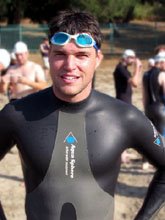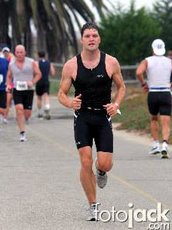There was a recent article on that 'We-Don't-Allow-No-Sissies' strength-training site, T-nation, about fragmentation within the strength-training community. T.C. Luoma argues that powerlifters and bodybuilders don't get along; figure models and female bodybuilders give each other the cold shoulder; mixed martial artists and practitioners of CrossFit stare angrily at one another from across the protein-shake bar. And no one serious about lifting weights wants to have much to do with those beanpole endurance athletes like runners or triathletes -- what are THEY trying to prove, anyway?
Now, you might not know who all these hypertrophied characters are -- suffice it to say that they're all variations on mesomorph types you wouldn't want to trifle with. I agree with Louma's point about the cliquey behavior of the different groups -- while at the same time still believing that, as Lou Schuler has suggested, there are more similarities than differences among their training methods. The serious rift, as I see it, is not how much resentment the average Powerlifter Pete has for the average Bodybuilding Bob, but rather their mutual disdain -- indeed, xenophobia -- for Pilates Priscilla, and other practitioners of different movement methodologies altogether.
And that's a shame, because looking outside the box -- and I mean WAY outside -- can cast fascinating new light on our usual, day-to-day practice, whether that involves lifting enormous amounts of weight, hitting a golf ball, spear fishing, or playing lawn darts. I'm not just talking about switching to a 4-iron or doing three sets of eight instead of two sets of fifteen. I'm talking about putting down the clubs and dumbells altogether and spending some time sitting at the feet of someone whose perspective you've never even considered.
Quick example: years ago I saw a video on something called the Alexander Technique, a movement system founded by an actor named F.M. Alexander who had a chronic problem with losing his voice on stage. Observing his own behavior carefully, he found that his neck and shoulders became tense whenever he made an entrance, constricting his breath and tightening his vocal cords when he spoke, and thus causing his frequent bouts of laryngitis.
To alleviate the problem, he developed a system of physical actions, reinforced by simple, internal verbal cues that counteracted his natural tendency towards tension. As a result of these cues, and the physical awareness they helped him develop, not only did his voice remain strong, but he found that he was far more energetic and spontaneous on stage, and far less exhausted afterwards. Codifying the technique, Alexander began teaching other performers, and they, too, began to move more freely and easily. Virtually all his students reported that any chronic pain they had been experiencing had disappeared, and that their physical endeavors now seemed smooth and natural.
All well and good, you say: Alexander's work may have relevance for performers who need to project an air of effortless relaxation on stage; but what about people who have to to produce real physical force, such as athletes and powerlifters? Does it help them?
The answer appears to be yes: perhaps the most striking aspect of the video was the footage of one of Alexander's disciples working with a karate practitioner who seemed tense and clumsy while performing his fighting moves. After the instructor made some simple adjustments to the man's neck, head and shoulders, his moves were not only flowing and energized, but clearly more powerful and effective as well. Though seemingly soft and internal in its approach, Alexander's methods also work well for practitioners of harder arts as well.
Apparently, the solution to getting stronger or faster, and perhaps leaner and more muscular, may not always lie in pushing harder and faster, but also in learning to work on a deeper, subtler level, to broaden one's awareness from simple, gross muscle movements to an almost dancer-like awareness of the entire body in motion.
The Alexander Technique is really just one of dozens of movement methods that are out there to be studied and learned from. For years I thought that a standard standing toe-touch was an effective hamstring stretch -- until I went to my first yoga class and discovered that I'd really just been reinforcing bad posture by over-flexing my spine. Leading back expert Stuart McGill has recently shown that people with back pain usually have stronger back muscles than people who are pain-free, thus debunking the common belief that strengthening the back will help alleviate pain. His solution? A series of fine-motor control movements that help his clients develop greater sensitivity, firing the correct muscles in the correct sequence for pain-free movement. Among his recommendations is advice on how to activate your tongue muscles for improved alignment!
Discussing tongue placement is not something that occurs to many strength and conditioning coaches (and no one, and I mean no one, has a mustache like McGill's).
In the ten-year period during which I practiced the martial arts, I must have studied with a dozen different teachers, all masters of one art or another. Occasionally I'd hear one of them enthusiastically recommend something that another teacher had vehemently rejected: a hand or foot placement during a block or a strike, perhaps, a particular style of footwork, maybe something about the optimal distance between you and an attacker. I liked hearing about the differing points of view because it reinforced my sense that the body's expressiveness was virtually limitless, that a given technique could be both foolish and brilliant, indispensable and execrable, depending on the context, point of view, and particular inclination of a given practitioner in a given moment.
The take-home lesson for muscleheads -- and as a 20-year veteran of strength training I'll happily include myself in that group -- is that we need to come out of our crustaceous, hypertrophied shells a bit and realize that in order to grow more, get stronger, and function ever more effectively, we'd do well to occasionally investigate entirely different schools of thought than the ones we're used to. I'd say that same to anyone who practices yoga and avoids strength training lest they "tighten up" or a t'ai chi master who refuses to experiment with kung fu lest it interfere with their perfectly balanced chi.
Even the smallest towns have master movement teachers out there, quietly passing on their lifetime of knowledge to anyone with an couple of free evenings a week. Seek them out. Let them open your mind a bit. Get out of your comfort zone. You'll probably get a lot out of the class, be smarter for it, and find a new perspective on your game of choice as well.
And they'll probably learn a lot from you, too.
(Last minute edit: Just read a new piece by T.C. Luoma in T-Nation that mentions tongue positioning during ab exercises! Oh, sweet irony!)
Thursday, June 28, 2007
Exhortation to Exploration
Labels:
Lou Schuler,
martial arts,
Stuart McGill,
T-Nation,
T. C. Luoma,
The Alexander Method,
yoga
Subscribe to:
Post Comments (Atom)




No comments:
Post a Comment